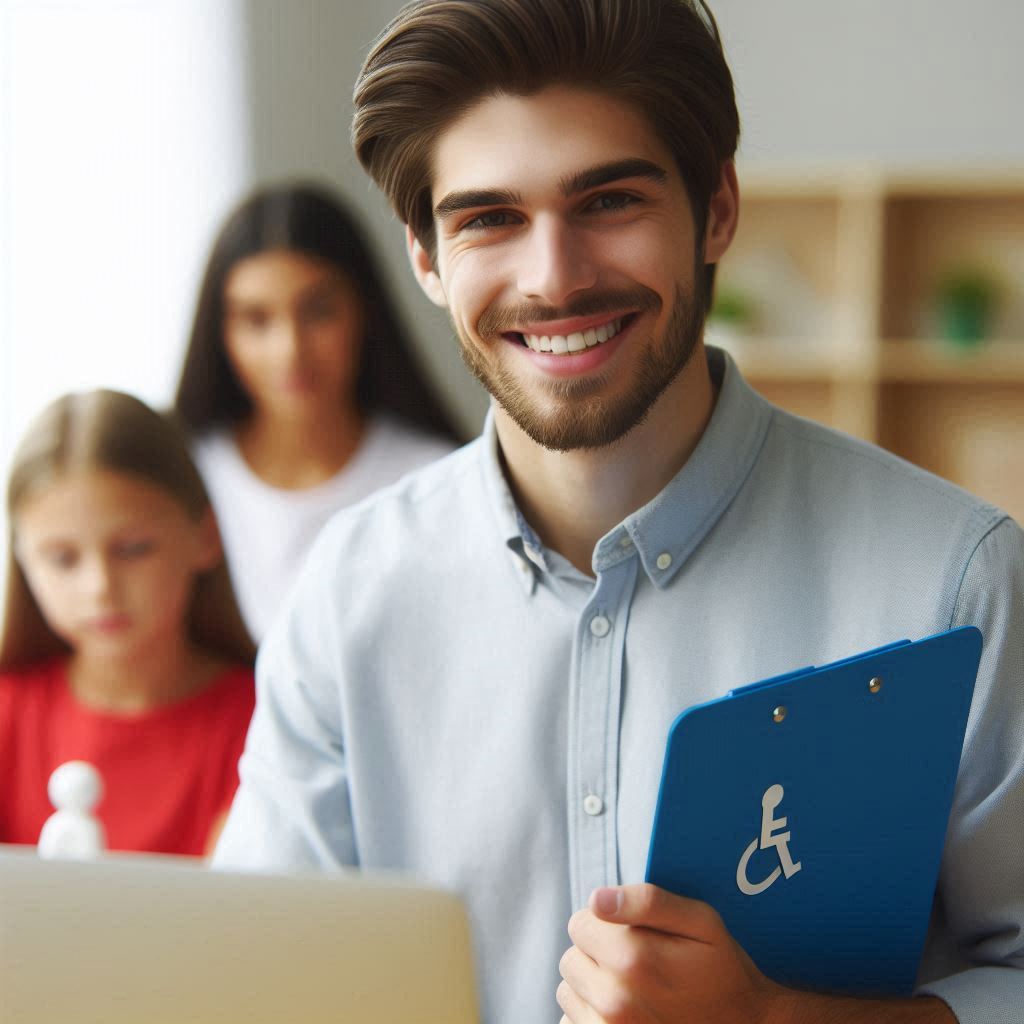Introduction
Collaboration between special education and general education teachers is crucial for student success.
Effective teamwork enhances learning outcomes for students with special needs.
When teachers work together, they create a more inclusive and supportive classroom environment.
Special education teachers bring expertise in individualized instruction and accommodations.
General education teachers offer insight into the curriculum and classroom dynamics. Their combined efforts can address the unique needs of each student.
This partnership helps in developing tailored teaching strategies that benefit all students.
Students with special needs thrive in classrooms where teachers coordinate their efforts.
They receive more personalized support and can participate more fully in classroom activities.
This approach ensures that students with diverse needs are not left behind. It promotes a more equitable learning environment.
The purpose of this blog post is to explore effective collaboration strategies.
We will discuss methods for improving communication, sharing responsibilities, and creating a cohesive teaching plan.
By implementing these strategies, teachers can enhance their collaborative efforts.
This will ultimately lead to better educational experiences and outcomes for students with special needs.
Establishing open communication
Effective collaboration between special education and general education teachers hinges on open communication.
This foundation is crucial for creating a supportive learning environment for all students.
Importance of open communication between special education and general education teachers
Open communication is vital for the success of inclusive education.
It ensures that both special education and general education teachers understand each other’s expectations and challenges.
When teachers communicate openly, they can better address the needs of students with diverse learning requirements.
This shared understanding promotes consistency in teaching approaches and enhances student support.
Regular check-ins or meetings to discuss student progress and individualized education plans
Regular check-ins or meetings are essential for tracking student progress and updating individualized education plans (IEPs).
Transform Your Career Today
Unlock a personalized career strategy that drives real results. Get tailored advice and a roadmap designed just for you.
Start NowSchedule weekly or bi-weekly meetings to discuss students’ academic and social development.
These sessions allow teachers to review the effectiveness of current strategies and make necessary adjustments.
Consistent meetings foster a collaborative approach to problem-solving and ensure that both teachers are aligned in their goals for each student.
Sharing of information, resources, and strategies to support all students in the classroom
Encourage teachers to share information, resources, and strategies.
This sharing can include teaching materials, instructional techniques, or behavioral management strategies.
By exchanging ideas and resources, teachers can develop more effective methods to support students.
This collaboration also helps in building a resource pool that benefits all students in the classroom.
When teachers work together to share best practices, they create a richer learning experience and ensure that all students receive the support they need.
In summary, establishing open communication through regular meetings and the sharing of resources is crucial.
This collaboration strengthens the partnership between special education and general education teachers, ultimately benefiting all students.
Read: Key Strategies Educational Consultants Use for Success
Setting clear roles and responsibilities
Roles and responsibilities of each teacher in the collaborative process
When collaborating with general education teachers, setting clear roles and responsibilities is crucial for the success of the partnership.
By defining and clarifying the duties of each teacher involved, there is greater clarity in how to work together effectively.
This clarity ensures that everyone knows what is expected of them and can perform their tasks efficiently.
Importance of understanding each other’s strengths and expertise
Understanding each other’s strengths and expertise is essential in a collaborative relationship.
General education teachers bring their unique skills and knowledge to the table, and special education teachers can benefit from tapping into this expertise.
By recognizing and appreciating each other’s strengths, teachers can leverage these qualities to create a more comprehensive and effective learning environment for all students.
The need for flexibility and willingness to adapt roles as needed to meet student needs
Flexibility and adaptability are also key components of successful collaboration.
Student needs can vary, and it is crucial for teachers to be willing to adjust their roles as necessary to meet these needs.
This may involve taking on different responsibilities, sharing workload, or collaborating in new ways to address emerging challenges.
Transform Your Career Today
Unlock a personalized career strategy that drives real results. Get tailored advice and a roadmap designed just for you.
Start NowBy remaining open to change and adaptable in their approaches, teachers can better support their students’ diverse needs.
Read: Technology Tools for Special Education Classrooms
Creating a supportive classroom environment
Benefits of creating a supportive and inclusive classroom environment for students with special needs
Creating a supportive classroom environment is crucial for the success of students with special needs. Here are some benefits of fostering such an environment:
- Promotes inclusion: By creating a supportive classroom, students with special needs feel included and valued, enhancing their sense of belonging.
- Encourages collaboration and teamwork: When students feel supported, they are more likely to collaborate with their peers, fostering a sense of teamwork in the classroom.
- Boosts self-esteem: A supportive environment helps students build confidence and self-esteem, leading to better academic and social outcomes.
Ways to promote collaboration and teamwork among students
To promote collaboration and teamwork among students, consider implementing the following strategies:
- Group activities: Assign group projects that require students to work together, fostering collaboration and communication skills.
- Buddy system: Pair students with special needs with a peer buddy who can provide support and encouragement throughout the day.
- Peer tutoring: Encourage students to help each other with assignments, promoting teamwork and a sense of responsibility within the classroom.
Strategies for addressing behavior challenges and promoting positive social interactions
Addressing behavior challenges and promoting positive social interactions is essential in creating a supportive classroom environment.
Here are some strategies to achieve this:
- Establish clear expectations: Set clear expectations for behavior and reinforce positive actions to create a sense of structure and consistency.
- Use positive reinforcement: Acknowledge and reward positive behaviors to encourage students to continue exhibiting them.
- Provide social skills training: Teach students social skills such as empathy, active listening, and conflict resolution to promote positive interactions.
By implementing these strategies, educators can create a supportive classroom environment where all students, including those with special needs, can thrive academically and socially.
Read: How Educational Consultants Improve Student Outcomes
Utilizing co-teaching models
Different co-teaching models
Co-teaching involves general education teachers and special education teachers working together in a shared classroom to support all students, including those with special needs.
Here are some different co-teaching models and how they can be implemented:
- Station Teaching: In this model, students are divided into groups and rotate between stations where they receive different forms of instruction or practice different skills.
This allows teachers to focus on specific student needs in smaller groups. - Parallel Teaching: In parallel teaching, both teachers are delivering the same content simultaneously to two smaller groups of students.
This can help provide additional support and differentiation for students with special needs. - Alternative Teaching: With alternative teaching, one teacher takes responsibility for the majority of the class while the other works with a smaller group of students, particularly those who need additional support or instruction.
This allows for more targeted assistance.
Benefits of co-teaching
- Increased student engagement: Co-teaching allows for more hands-on, interactive learning experiences that can engage students of all abilities.
- Differentiated instruction: With two teachers in the classroom, instruction can be tailored to meet the diverse needs of all students, including those with special needs.
- Enhanced collaboration: Co-teaching fosters a collaborative environment where teachers can share ideas, resources, and strategies to support student learning.
Examples of successful co-teaching strategies and activities
- Incorporating peer tutoring: Pairing students with special needs with peer mentors can provide additional support and encourage peer-to-peer learning.
- Utilizing visual aids and manipulatives: Visual aids and hands-on materials can help students with special needs better understand and engage with the content.
- Implementing flexible grouping: By regularly changing groupings based on student needs, teachers can ensure that all students are receiving appropriate levels of support and challenge.

Providing professional development opportunities
Ongoing professional development opportunities for teachers to enhance their collaboration skills
Advocating for ongoing professional development is crucial for enhancing collaboration skills among teachers.
Regular training sessions ensure that educators stay updated with best practices. Effective collaboration requires continuous learning and improvement.
Encourage teachers to attend workshops and seminars focusing on collaboration strategies.
Support from school administration can make a significant difference in professional growth.
Ensure that teachers have access to resources and time for development activities.
Ongoing professional development strengthens teamwork and improves student outcomes.
Benefits of training and workshops on special education topics
Training and workshops on special education topics offer numerous benefits. They provide educators with strategies to effectively support diverse learners.
Specialized training helps teachers understand various learning needs and accommodations.
Workshops can cover topics such as differentiated instruction and behavior management techniques.
By attending these sessions, teachers can develop practical skills and strategies.
Transform Your Career Today
Unlock a personalized career strategy that drives real results. Get tailored advice and a roadmap designed just for you.
Start NowThis knowledge enhances their ability to collaborate with special education professionals.
Ultimately, it leads to a more inclusive and supportive learning environment.
Resources for finding professional development opportunities related to collaboration with general education teachers
Several resources can help educators find professional development opportunities related to collaboration.
Online platforms offer numerous courses and webinars on collaboration strategies. Professional organizations often provide training and resources for educators.
Websites like Edutopia and the National Education Association (NEA) list various workshops and conferences.
Local educational institutions may offer relevant courses and training sessions. Encourage teachers to explore these resources to enhance their collaboration skills.
Staying informed about available opportunities can lead to more effective and productive teamwork.
By promoting and supporting professional development, schools can improve collaboration between general and special education teachers. These efforts lead to better educational experiences for all students.
Read: Adapting Curriculum for Students with Physical Disabilities
Using technology to facilitate collaboration
Technology plays a crucial role in enabling collaboration between special education and general education teachers.
By leveraging various tools and platforms, educators can enhance communication, streamline resource sharing, and ultimately improve outcomes for students with diverse learning needs.
Role of technology in supporting collaboration
Technology serves as a bridge that connects educators from different backgrounds and facilitates the exchange of ideas, strategies, and best practices.
It enables real-time communication, collaboration on lesson planning, and tracking student progress collectively.
Benefits of using online platforms
Online platforms provide a centralized space for teachers to share resources, collaborate on instructional materials, and communicate effectively.
These platforms offer flexibility, accessibility, and convenience, making it easier for educators to work together regardless of their physical location.
Examples of technology tools for collaboration
- Google Drive: Allows teachers to create, store, and share documents, spreadsheets, and presentations, fostering collaboration on lesson plans and student progress tracking.
- Microsoft Teams: Enables real-time communication, file sharing, and collaboration on projects, making it easier for teachers to work together and coordinate efforts.
- Zoom: Facilitates virtual meetings, webinars, and professional development sessions, allowing educators to connect and collaborate remotely.
- Padlet: Offers a digital canvas for sharing ideas, resources, and feedback, promoting collaboration and creativity among educators.
- Remind: Allows teachers to send messages, announcements, and updates to colleagues and students, enhancing communication and collaboration.
Overall, technology serves as a powerful tool in promoting collaboration between special education and general education teachers.
By embracing digital platforms and tools, educators can work together more efficiently, share resources effectively, and ultimately create a more inclusive and supportive learning environment for all students.
Collecting and analyzing data
Tracking student progress and evaluating collaboration strategies is crucial in promoting student success.
The importance of data collection
Collecting and analyzing data is crucial for tracking student progress and evaluating collaboration strategies.
It provides concrete evidence of student growth and areas needing improvement.
Transform Your Career Today
Unlock a personalized career strategy that drives real results. Get tailored advice and a roadmap designed just for you.
Start NowBy analyzing data, educators can identify patterns and measure the success of their strategies.
Data helps in setting realistic goals and adjusting teaching methods to better support students.
Regular data collection ensures that adjustments are timely and based on actual performance, enhancing overall effectiveness.
Data-driven decision making
Data-driven decision-making plays a vital role in improving outcomes for students with special needs.
It involves using collected data to make informed choices about instructional practices.
This approach helps tailor interventions to meet individual needs effectively.
By relying on data, educators can pinpoint what works and what doesn’t, allowing for targeted adjustments.
Data-driven decisions support personalized learning plans and ensure that resources are allocated efficiently.
Tips for effectively collecting, analyzing, and using data to inform instructional practices
- Establish Clear Goals: Define what you want to achieve with your data collection. Clear goals guide the process and focus efforts.
- Use Consistent Methods: Apply the same data collection methods across different students and times to ensure reliability.
- Select Relevant Metrics: Choose metrics that align with your goals and provide meaningful insights into student progress.
- Regularly Review Data: Schedule regular intervals for data review to stay updated on student progress and adjust strategies as needed.
- Collaborate with Colleagues: Share data insights with general education teachers to align strategies and enhance overall effectiveness.
- Leverage Technology: Utilize data management tools and software to streamline data collection and analysis.
- Incorporate Feedback: Use feedback from data to make informed changes and continuously improve instructional practices.
By effectively collecting, analyzing, and using data, educators can enhance their collaboration strategies and better support students with special needs.
Conclusion
Collaboration between special education and general education teachers is crucial for the success of students with special needs.
By working together, teachers can create a supportive learning environment that meets the diverse needs of all students.
It is essential to recognize the unique strengths and abilities that each teacher brings to the table.
By combining their expertise, teachers can develop effective strategies and interventions to support students with special needs.
Implementing the collaboration strategies outlined in this blog post can make a significant difference in the academic and social outcomes of students with special needs.
It is important for educators to prioritize collaboration and communication in order to provide the best possible education for all students.
[E-Books for Sale]
The Big Book of 500 High-Paying Jobs in America: Unlock Your Earning Potential
$19.99 • 500 High-Paying Jobs • 330 pages
Explore 500 high-paying jobs in America and learn how to boost your career, earn more, and achieve success!
See All 500 High-Paying Jobs of this E-Book
1001 Professions Without a Degree: High-Paying American Jobs You Can Start Now
$19.99 • 1001 Professions Without a Degree • 174 pages
Discover 1001 high-paying jobs without a degree! Unlock career tips, skills, and success strategies for just $19.99!




